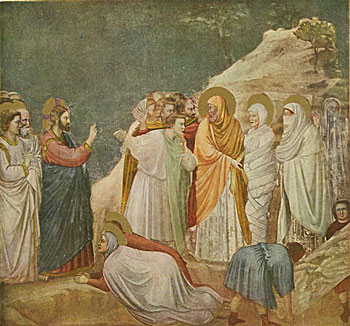
John
W. Dixon, Jr., Art
as a Means of Thinking and of Grace

Lazarus is a corpse, pale and decaying and, as the gesture of those
near him shows, stinking. He is erect but weakly so, supported by those
at his side.
The small group of the disciples behind Jesus closes off that side
of the painting while leading into the picture. Their calm verticality
reinforces the majestic vertical of the figure of Jesus. Those around
Lazarus emphasize the vertical by their swaying departure from it. They
are in a state of excitement, worshipful astonishment.
All the figures are in groups, except Jesus, who stands in domination
against the blue of the sky. He raises his hand as he calls Lazarus
forth from the grave. All around him, the people move variously, turning
or bending away from the vertical. Only Jesus stands fully erect in
grave majesty. His silhouetted face is majestically calm amid the surrounding
excitement. Whereas the other figures are dressed in white or lovely
soft colors, Jesus is dressed in deep, noble colors, again setting him
majestically apart. His gesturing hand is isolated against the sky,
the source of the imperiously healing energy that is carried along the
gesturing arms of the onlookers.
For Lazarus, the gesture is the revivifying energy of the grace of
God. To the others the energy of the gesture is the astonishing revelation
of the healing power of God present among them.



